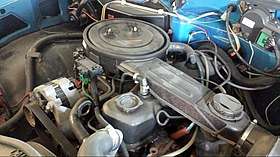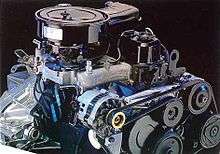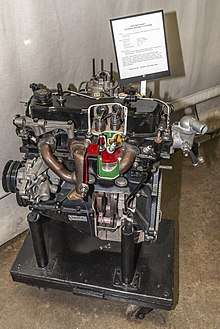Iron Duke engine
The Iron Duke engine (also called 151, 2500, Pontiac 2.5, and Tech IV) is a 151 cu in (2.5 L) Straight-4 piston engine built by the Pontiac Motor Division of General Motors from 1977 to 1993. Thereafter GM's 2.2 L OHV 4-cylinder replaced it across the entire lineup of vehicles that offered it. Although its original purpose was to serve as Pontiac's new economy car engine it was later adapted for use in wide variety of applications across GM's lineup in the 1980s.
 | |
| Overview | |
| Manufacturer | General Motors |
| Also called | Tech IV (1982-1990) |
| Production | 1977–1993 |
| Layout | |
| Displacement | 150.8 cu in (2.5 L) |
| Cylinder bore | 4 in (101.6 mm) |
| Piston stroke | 3 in (76.2 mm) |
| Block material | Iron |
| Head material | Iron |
| Valvetrain | OHV 2 valves x cyl. |
| Compression ratio | 8.25:1 (1977–1983) 9.0:1 (1984–1993) |
| RPM range | |
| Redline | 5000 rpm |
| Combustion | |
| Fuel system | Carburetor Throttle-body fuel injection |
| Fuel type | Gasoline |
| Cooling system | Water-cooled |
| Output | |
| Power output | 85–110 hp (63–82 kW) |
| Specific power | 34.4 hp (25.7 kW)-44.5 hp (33.2 kW) per liter |
| Torque output | 123–135 lb⋅ft (167–183 N⋅m) |
| Dimensions | |
| Dry weight | 375 lb (170 kg)[1]:3 |
| Chronology | |
| Predecessor | GM 2300 engine |
| Successor | GM 122 engine |
Development
At the time of the 1973 oil crisis the only engines Pontiac built were 350 cu in (5.7 L), 400 cu in (6.6 L) and 455 cu in (7.5 L) versions of their V8 engine. Recognizing that future products would need to be smaller and more fuel-efficient, Pontiac engineers were tasked with developing a new engine that would be suitable for these future products. The engineers considered developing smaller displacement versions of the existing V8, a V6 derived from the V8, a V4 derived from the V8, and an inline-four derived from one of the cylinder banks of the V8 (in the same fashion the 1961 Pontiac Tempest's "Trophy 4" engine), but ultimately decided to create an entirely new four-cylinder engine.[1]:1
The development team's design goals were to minimize noise and vibration while maximizing durability, drivability, fuel economy, and "usable" power at lower engine speeds.[1]:1 They began by analyzing other four-cylinder engines in production at General Motors at the time, and they found that GM do Brasil's 151 cu in (2.5 L) version of the Chevrolet 153 cu in four-cylinder—with a shorter 3-inch (76 mm) stroke and longer 6-inch (150 mm) connecting rods—had significantly reduced secondary vibration as compared to the original Chevrolet design and the newer 2.3 L four-cylinder from the Chevrolet Vega.[1]:1-2 This obviated the need for counter-rotating balance shafts, which would have increased the weight, complexity and cost of the engine.[1]:3 Despite sharing the same bore, stroke and cylinder spacing as the Brazilian engine the majority of parts are not interchangeable.[1]:2
Focusing on making power at lower engine speeds was a deliberate consideration in order to meet the rest of the design goals. Careful consideration was made to the design of the intake manifold and exhaust gas recirculation system to ensure power output from each cylinder was equalized. Power consumption of the water and oil pumps were reduced, and the piston rings, cylinder bores and crankshaft journals were designed to minimize friction.[1]:3-5
To maximize durability the engine block was made of cast iron with five main bearings, rather than the relatively fragile cast aluminum block used by the 2.3 L Vega engine. (Even with the cast iron block the Iron Duke only weighed about 20 pounds more.) The 2.3 L engine's belt-driven overhead camshaft was eschewed in favour of an overhead valve design with timing gears. Specially-designed bolts that stretch slightly farther than a conventional bolt were used to secure the intake and exhaust manifolds to the cylinder head, to allow slight movement while maintaining the seal of the gaskets in order to prevent cracking the manifolds as they expand with heat.[1]:6-7
A two-stage, two-barrel carburetor with electric choke was used to improve performance in cold starts, while heat shields incorporated underneath the carburetor and between the intake and exhaust manifolds were used to prevent heat soaking the gasoline in the carburetor thereby improving performance in hot weather. Recognizing that cars with four-cylinder engines equipped with air conditioning tended to experience drivability issues in hot weather, other improvements were made including a cut-off switch that shut the compressor off at wide open throttle and a delay incorporated into the air conditioning's circuitry to prevent the compressor from engaging on until twelve seconds after the engine was started.[1]:7-10
Early Applications
The Iron Duke's first applications were in the 1977 Astre and Sunbird subcompact cars, replacing the 2.3 L Vega engine, and in the compact Phoenix. As these cars were originally designed for Chevrolet engines the Iron Duke also used the Chevrolet bell housing bolt pattern, instead of the Buick-Oldsmobile-Pontiac V8 pattern. The following year use of the engine expanded to the Sunbird's Chevrolet and Oldsmobile twins, the Monza and Starfire.
For model year 1979 the engine was extensively redesigned. The original reverse-flow cylinder head was replaced by a crossflow design, a new two-barrel carburetor called "Vara-Jet" was introduced, the distributor was relocated, and the size of the oil pan was reduced. The only parts carried over from the 1978 engines were the connecting rods.[2] Peak power increased to 90 hp.
For 1980 the Iron Duke engine was redesigned to be mounted transversely, to suit the new front-drive General Motors "X-body" cars. The bellhousing bolt pattern was revised to match that of the new 60° V6 engine.
GM also began selling the engine to AMC, for use in their 1980 model Spirit, Concord and Eagle, and (as the Hurricane) in base-model Jeep CJs. (The engines sold in AMCs continued to use the Chevrolet V8 bellhousing pattern.) AMC used the Iron Duke as a base engine in their cars until it was replaced with a 150 cu in (2.5 L) four-cylinder of their own design in 1984.
| Year | Power | Torque |
|---|---|---|
| 1978 | 85 hp (63 kW) @ 4400 rpm[3]:40 | 123 lb⋅ft (167 N⋅m) @ 2800 rpm[3]:40 |
| 1979 | 90 hp (67 kW) | 128 lb⋅ft (174 N⋅m) |
| 1980 | 90 hp (67 kW) @ 4000 rpm[4]:47 | 134 lb⋅ft (182 N⋅m) @ 2400 rpm[4]:47 |
| 1981 | 84 hp (63 kW) @ 4000 rpm[5] | 125 lb⋅ft (169 N⋅m) @ 2400 rpm[5] |
- 1977 Pontiac Astre
- 1977–1979 Pontiac Phoenix
- 1977–1980 Pontiac Sunbird
- 1978–1980 Chevrolet Monza, Oldsmobile Starfire
- 1980–1982 AMC Concord
- 1980–1982 AMC Spirit
- 1980–1983 Jeep CJ
- 1980–1984 Oldsmobile Omega, Pontiac Phoenix
- 1980–1985 Buick Skylark, Chevrolet Citation
- 1981–1983 AMC Eagle
Tech IV (1982-1990)

Iron Dukes were fitted with fuel injection (TBI, via a single injector in the throttle body) in 1982. This version was christened the Tech IV, though Car and Driver later ridiculed it as the low-Tech IV. Power output increased to 90 hp (67 kW).[6]


This was replaced by a swirl-port head with 9.0:1 (instead of 8.25:1) compression ratio in 1984 for a 2 hp (1.5 kW) gain. Other additions for 1985 included roller lifters, improved bearings, and a new crankshaft. Several significant changes were made in 1987, which included: an improved cylinder head, intake manifold and throttle-body fuel injection module, a more-modern serpentine belt with an automatic spring-loaded tensioner for the accessories, and a Distributorless Ignition System (DIS). This revision to the engine increased power to 98 hp (73 kW). In 1988, a balance shaft was added to smooth engine vibrations. Up to this point, the engine incorporated a 'dogbone' upper front engine mount secured to the cowling of the vehicle's hood latch, aiding in controlling the vibration. Further improvements in later years included new pistons, rods, crankshaft, and an in-pan oiling system. The most powerful variant of the Tech IV raised the rev limit to 5500 rpm, and achieved 110 hp (82 kW). The Tech IV uses the same bellhousing pattern as the 2.8 L 60-Degree V6. Over the years, the Tech IV engine has proved to be a reliable workhorse for owners when not pushed to its limits. All 1978-1990 Iron Duke engines used a micarta camshaft gear that meshed directly with a steel gear on the crankshaft. 1991-92 VIN R and U engines used a timing chain instead.
- 1982–1985 Chevrolet Camaro, Pontiac Firebird
- 1982–1989 Chevrolet Celebrity
- 1982–1991 Pontiac 6000
- 1982–1992 Buick Century, Oldsmobile Cutlass Ciera
- 1984–1988 Pontiac Fiero
- 1985–1987 Chevrolet S-10 Blazer, GMC S-15 Jimmy
- 1985–1993 Chevrolet S-10, GMC S-15/Sonoma
- 1985–1990 Chevrolet Astro, GMC Safari
- 1985–1987 Buick Somerset
- 1985–1991 Pontiac Grand Am, Oldsmobile Cutlass Calais
- 1986–1991 Buick Skylark
- 1987–1994 Grumman LLV (USPS delivery vehicle)
- 1990–1992 Chevrolet Lumina
Problems with the Iron Duke
The timing gear has a tendency to crumble a tooth anytime after 80,000 mi (130,000 km). The cam gear simply shears a tooth at startup and the engine won't start; because of the non-interference design of the engine, no further damage occurs. When the cam gear loses a tooth, the camshaft and distributor stop rotating during engine cranking. Replacing the gear requires heating the new gear in hot oil and quickly installing it for a shrink fit on the cam stub. One upgrade is the use of the aluminum camshaft timing gear from a Chevrolet 250 inline six with the Iron Duke's crankshaft timing gear. Inspection (and replacement, if necessary) of the MAP sensor, and its accompanying vacuum hose, is often a solution to many driveability problems. This sensor largely controls the engine's driveability. Stuck EGR Valves are also very common on the Tech IV.
Super Duty
The Iron Duke block formed the basis of Pontiac's Super Duty four-cylinder racing engines of the 1980s, the last in a line of high-performance Pontiac Super Duty engines. The engines were featured in NASCAR's Charlotte/Daytona Dash Series, the IMSA GT Championship (in GTP and GTU class cars), and even in American Power Boat Association racing boats. Super Duty engines continued to be used in ARCA racing until well into the 2000s.
| Displacement | Stroke |
|---|---|
| 2.1 L (131 cu in) | 2 3⁄5 in (66.0 mm) |
| 2.5 L (151 cu in) | 3 in (76.2 mm) |
| 2.7 L (163 cu in) | 3 1⁄4 in (82.6 mm) |
| 3.0 L (182 cu in) | 3 5⁄8 in (92.1 mm) |
| 3.2 L (198 cu in) | 3 15⁄16 in (100.0 mm) |
In addition to parts matching the Iron Duke's stock 2.5 L displacement other crankshafts and their corresponding connecting rods were offered by Pontiac Motorsports, resulting in displacements ranging from 2.1 L to 3.2 L. A 2.7 L, 232 hp (173 kW) Super Duty engine powered the 1984 Fiero Indy Pace Car to over 138 mph (222 km/h) during the race, but Super Duty engines were never available in factory-built GM vehicles. However, GM sold the Super-Duty-specific parts at authorized dealers; a hobbyist could order all of the parts required to convert their stock Iron Duke engine to a Super Duty version.
Kansas Racing Products continued to make the engines in the early 21st century after buying rights to make them from GM.
Cosworth also produced a 16-valve, double-overhead cam head for the 3.0 L version of the racing engine (Cosworth Project DBA, 1987).[7]
See also
- GM H platform
- GM engines
References
- 1979 chevy Monza Brochure
- Sawruk, John M. (26–30 September 1977). Pontiac's New 2.5 Litre 4 Cylinder Engine (PDF). Society of Automotive Engineers: Passenger Car Meeting. Detroit. Archived from the original (PDF) on 5 February 2018. Retrieved 17 August 2019.CS1 maint: date format (link)
- Weissler, Paul (November 1978). "Servicing the '79 GM Cars". Popular Mechanics. New York: The Hearst Corporation. pp. 162–164. Retrieved 17 August 2019.
- Dunne, Jim; Jacobs, Ed (August 1978). "Small-engine sport sedans—good handling, tame performance". Popular Science. New York: Times Mirror Magazines, Inc. Retrieved 18 August 2019.
- Dunne, Jim; Jacobs, Ed (July 1979). "GM's X-cars challenge traditional compacts". Popular Science. New York: Times Mirror Magazines, Inc. Retrieved 18 August 2019.
- Dunne, Jim; Jacobs, Ed (March 1981). "U.S. compacts: Is Chrysler's K-car the new champ?". Popular Science. New York: Times Mirror Magazines, Inc. p. 46. Retrieved 27 August 2019.
- Dunne, Jim (February 1982). "Are carburetors kaput? Coming: throttle-body injection". Popular Science. New York: Times Mirror Magazines, Inc. p. 52. Retrieved 27 August 2019.
- "Cosworth Type Reference". Race-cars.com. Retrieved 2012-06-04.
External links
| Wikimedia Commons has media related to General Motors Iron Duke engines. |